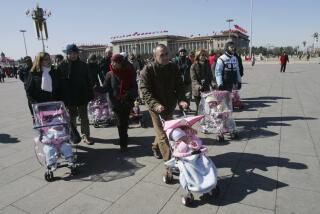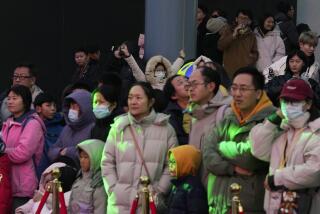China Issues Report on Children
- Share via
BEIJING — In a lengthy report on the status of China’s 300 million children--one-fifth the world’s total--the government Wednesday acknowledged “much room for improvement,” particularly in the areas of rural education and care for the disabled.
But the report released here by China’s State Council, or Cabinet, strongly denied allegations by a New York human rights organization that infants admitted to state orphanages are victims of systematic neglect resulting in many unnecessary deaths.
The Jan. 7 study by Human Rights Watch/Asia, titled “Death by Default,” cited government statistics to show that more than half the children admitted to state orphanages ultimately die there.
The Human Rights Watch/Asia report, based largely on documents provided by a whistle-blowing former physician at a state orphanage in Shanghai who recently immigrated to the United States, stirred international concern. More recently, the organization has faced a backlash from adoption groups in the United States and Europe that have questioned the statistical and ethical foundations of its 331-page document, which was based on 1989 statistics.
China last year became the largest foreign source of children adopted by U.S. parents.
In an appendix to its “White Paper on the Situation of Children in China” released Wednesday, the Chinese government described the Human Rights Watch/Asia allegations as “pieced together out of distorted and exaggerated material.”
Most of the government report focused on conditions for children in the world’s most populous country. It noted that infant mortality in China has improved from more than 200 deaths per 1,000 live births in 1950 to 37 deaths per 1,000 births today. It reported with pride the country’s successful immunization program.
The government restated its commitment to nine years of compulsory education. In 1995, the government reported a national enrollment rate in primary schools of more than 88.5%. The enrollment of school-age girls was reported to be only slightly lower: 88.2%.
But the report also noted that wide disparities exist between children in urban and rural settings:
“The incidence of disease among children in the countryside is comparatively high and in some poor areas children’s nutrition is below the normal level. As for children’s education, the teaching conditions in some outlying and poor areas are not up to par and the phenomenon of primary and middle school children discontinuing their studies still exists.
“As for the protection of disabled children, the state is not able to amass in a short period enough money to fully satisfy the actual needs in the protection of those children.”
The government said that 20,000 children are in the care of state orphanages, “accounting for five per 100,000 juveniles in China.”
The government did not respond to statistics in the Human Rights Watch/Asia report that alleged a high rate of death among children who are disabled or suffering from malnutrition.
However, the report said, “In 1995, the number of sick or disabled children in these homes nursed back to health reached over 200 and a total of 40% of the children in welfare training homes took part in rehabilitation training programs.”
In addition to the government’s announcement of the report on the status of children in China, state television Wednesday night cited an academic report stating that there are more than 1 million neglected children in the United States. With the United Nations Commission on Human Rights meeting in Geneva this month, and set to consider a resolution criticizing China, the Beijing government has devoted extensive coverage to what it describes as human rights problems in the United States, including crime, drug addiction, sexual abuse and AIDS.
The report on children appeared to be one part of the government’s effort to put the most positive light possible on China’s human rights situation during the Geneva conference.
More to Read
Sign up for Essential California
The most important California stories and recommendations in your inbox every morning.
You may occasionally receive promotional content from the Los Angeles Times.













